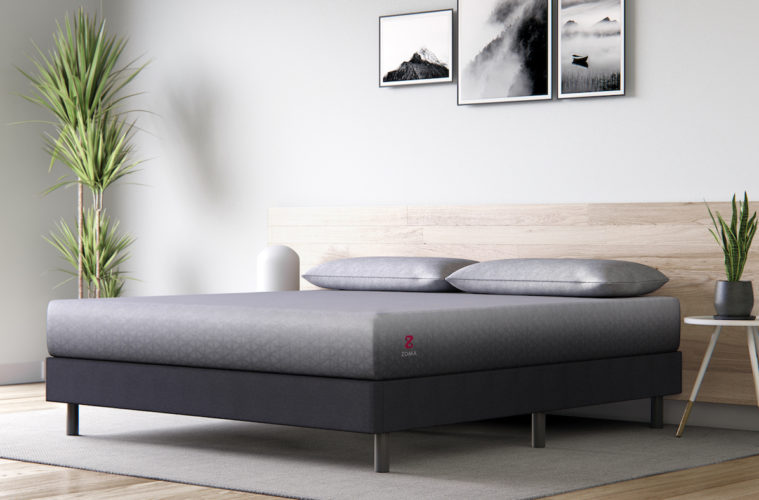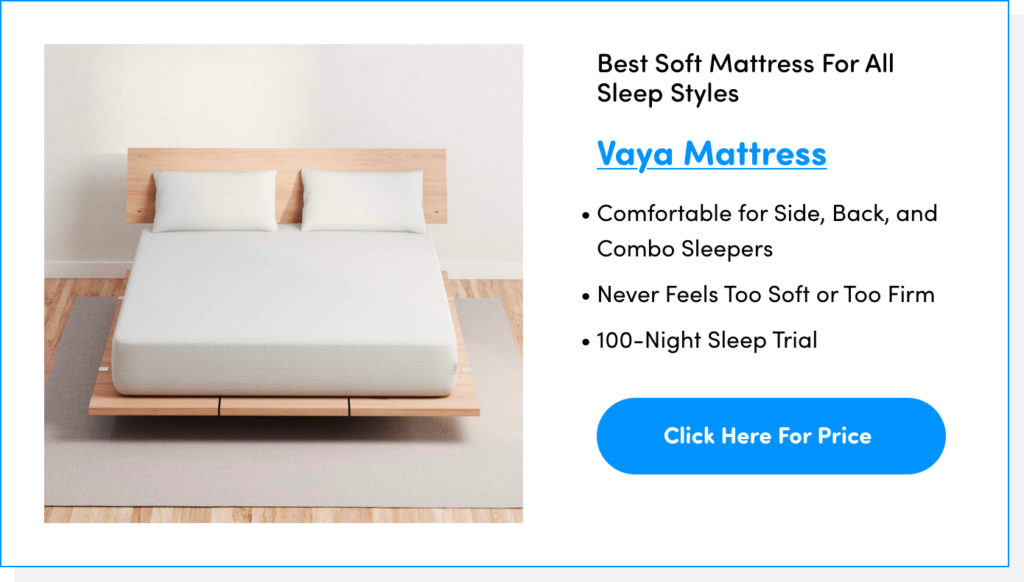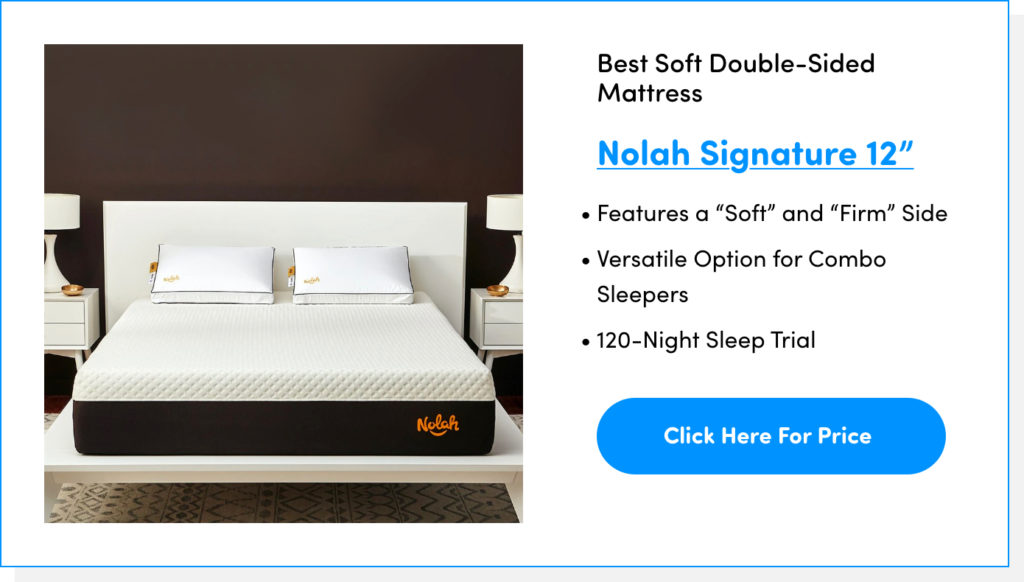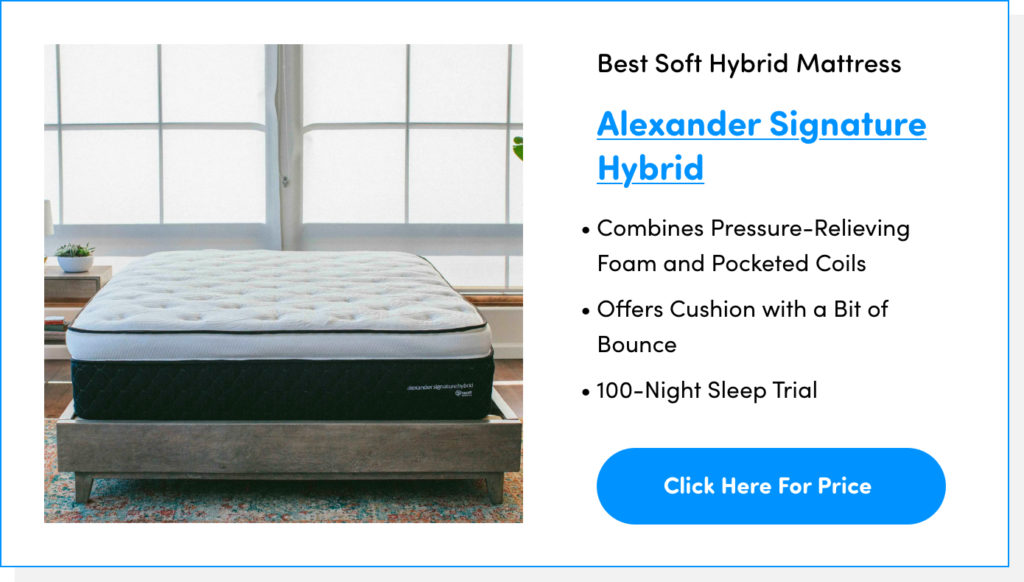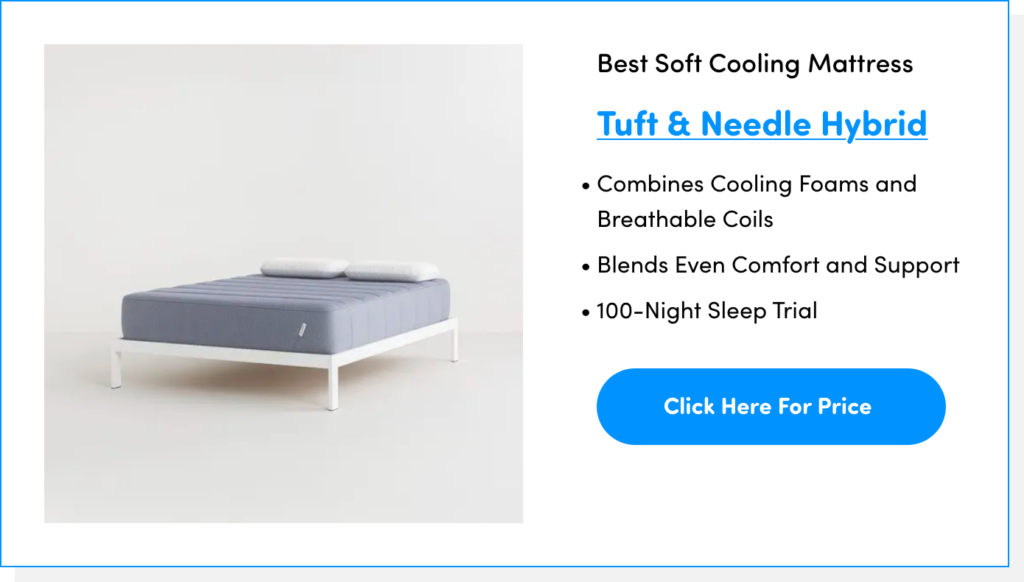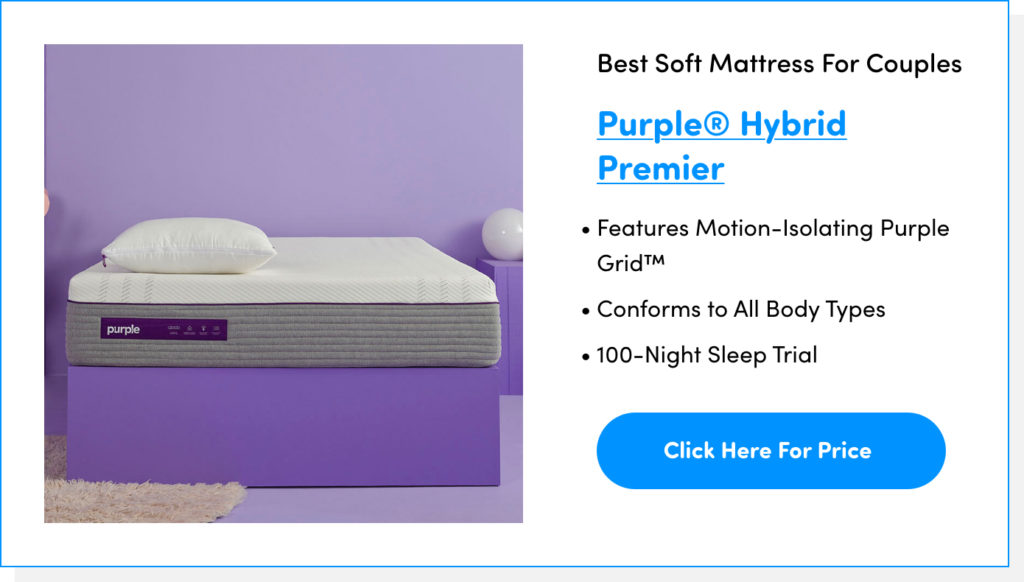Many of us yearn to curl up in a soft bed at night, and for good reason. Soft mattresses are some of the best beds for pressure relief, particularly if you’re looking for an excellent mattress for side sleeping. And while soft mattresses are often associated with luxury and high prices, many come at an affordable price.
It can be challenging to judge a mattress’s soft feel if you’re shopping online without the chance to try a showroom model. Buying a mattress with a sleep trial, whether online or in-stores, will make returning a too-firm bed far easier.
To simplify your shopping, we compiled a list of some of our favorite soft mattresses of 2022. A few are even adjustable or dual-sided, so you can experiment and find your perfect mattress firmness.
Best Soft Mattresses of 2022 Overview
- Best Soft Mattress Overall: Amerisleep AS5 Hybrid
- Best Soft Memory Foam Mattress: Zoma Mattress
- Best Soft Budget Mattress: Vaya Mattress
- Best Soft Double-Sided Mattress: Nolah Signature 12”
- Best Soft Hybrid Mattress: Nest Bedding Alexander Signature Hybrid
| Mattress Name | Highlights | Offer |
| Amerisleep AS5 Hybrid | Contains eco-friendly Bio-Pur® and targeted pocket coils for an all-around plush feel | Click For Lowest Price |
| Zoma Mattress | Gel memory foam and Triangulex™ technology provide a cool and soft surface | Click for Lowest Price |
| Vaya Mattress | 12-inch affordable design that’s soft enough for all sleeping styles | Click for Lowest Price |
| Nolah Signature 12” | Dual-sided memory foam lets you choose between soft and firm | Click for Lowest Price |
| Nest Bedding Alexander Signature Hybrid | Adjustable feel with a replaceable comfort layer | Click for Lowest Price |
| Tuft & Needle Hybrid | T&N Adaptive® foam responds to your movements for a soft, comfortable feeling | Click for Lowest Price |
| Purple® Hybrid Premier | Purple Grid™ relaxes and supports you as needed | Click for Lowest Price |
Best Soft Mattress Overall: Amerisleep AS5 Hybrid
Amerisleep understands different sleepers have different needs. That’s why the company offers its mattresses in five firmness levels, to accommodate all sleepers better. Its softest model is the AS5, which features a blend of plush comfort and responsiveness that prevents your mattress from “swallowing” you.
The AS5 is available as a memory foam mattress and as a hybrid. In this post, we will focus on the hybrid mattress and its unique layers since it feels a touch more responsive than their AS5 memory foam model.
All Amerisleep mattresses have a comfort layer of Bio-Pur® topped with a soft, breathable cover. The company produces Bio-Pur® by replacing select petrochemicals with castor oil. The result is a more breathable, responsive, and environmentally-friendly foam. The AS5 Hybrid has 3 inches of Bio-Pur®.
Two inches of Active Flex form the second layer. The AS5 is the only Amerisleep mattress with this material, which maintains a soft feel without sacrificing support. Too many soft mattresses have thick comfort layers without protection against sinkage. Active Flex is Amerisleep’s answer to that.
The hybrid model has 8 inches of pocketed coils underneath the Active Flex layer. By encasing coils in individual fabric pockets, Amerisleep minimizes motion transfer for an undisturbed night’s rest. The coils rest on a 1-inch-thick base of firm foam. Stiff foams surround the coil layer and form the bed’s perimeter. These foams add edge support without compromising the bed’s plush feel.
A queen-size AS5 Hybrid is $2,099 and every Amerisleep mattress includes a 100-night sleep trial and a 20-year warranty.
Best Soft Memory Foam Mattress: Zoma Mattress
We’ve all had days where we woke up at less than 100 percent. Too often, the cause is interrupted sleep. The makers of the Zoma Mattress seek to solve that with a bed that promotes deeper sleep and better recovery.
How does the Zoma Mattress affect your sleep for the better? The bed has soft memory foams that alleviate pressure and pain points and unique technology that minimizes sleep disturbances.
There are three foam layers, bringing the Zoma Mattress to a total height of 11 inches. Plus, the mattress is wrapped in an elastic polyester cover for breathability.
The top layer is 2 inches of gel memory foam to cool hot sleepers. The gels wick away body heat while the memory foam fits to your curves for full-body pressure relief.
The first layer also includes triangular cutouts under your shoulders and legs, a technology known as Triangulex™. Triangulex™ is present in the upper and lower thirds of the mattress for added pressure relief. Its absence in the middle maintains the support needed to prevent spine misalignment and back pain.
Two inches of latex-like Reactiv™ foam help the mattress respond faster to your movements. Without Reactiv™, you might feel stuck in the top layer or bottom out against the firm support layer.
The base layer is 7 inches of Support+ foam. Support+ foam extends the mattress’s lifespan, giving you excellent value for your dollar.
A Zoma Mattress is one of the more inexpensive soft memory foam mattresses, costing $750 for a queen. Included are a 100-night sleep trial and a 10-year warranty that covers sagging over 0.75 inches.
Best Soft Budget Mattress: Vaya Mattress
Some think of luxurious, plush mattresses as the height of expense. The Vaya Mattress goes against that expectation by having 12 inches of soft support at an affordable price.
A breathable and stretchy rayon-polyester knit covers the mattress. It’s woven to better wick away warm air, preventing heat build-up.
Three inches of plush Vaya Comfort Foam top the mattress. This specialized poly-foam mimics the soft contouring of traditional memory foam while maintaining a cooler temperature. Its latex-like responsiveness prevents you from ever feeling “trapped” in your bed.
The bottom layer is 9 inches of Vaya Base Foam. It’s a higher density polyurethane foam made to support your body while resisting compression and sagging. No matter what sleep position you prefer, the soft and budget-friendly Vaya Mattress will support you.
At only $599 for a queen, the Vaya Mattress is one of the best budget mattresses of 2022. It also comes with a 100-night sleep trial and a full-replacement 10-year warranty. With care, the mattress can last a decade (or even longer).
Best Soft Double-Sided Mattress: Nolah Signature 12”
The flippable Nolah Signature Mattress is basically a two-for-one deal. Each side of this mattress has a different firmness, one soft and the other firm. If you have trouble deciding which feel you would prefer, Nolah saves you from buying two mattresses to find out.
This 12-inch tall mattress has four foam layers. We will discuss its construction from the soft side down.
The first layer is 2.5 inches of AirFoam™, a material that’s not as temperature-sensitive as traditional memory foam. It’s a breathable material that promotes a cool night’s sleep. AirFoam™ is also resilient and reduces pressure in your shoulders and hips, making it an excellent match for side sleepers.
Underneath is a 1.5-inch layer of bouncy, durable foam that’s designed to be tougher than latex. It deters sag and prevents you from bottoming out on the support foam, which would negate the side’s soft feel.
Seven inches of breathable base foam support the mattress. It not only resists sagging but also improves the bed’s contouring for more pressure relief.
The firm side’s comfort layer is an inch of AirFoam™. It relieves pressure while providing a supportive sleeping surface.
The Nolah Signature is $1,569 for a queen. It includes a 120-night trial and a limited lifetime warranty. Nolah covers all costs for repairs and replacements for the first 15 years. Once 15 years have passed, you will pay a prorated charge for repairs, replacements, and shipping.
Best Soft Hybrid Mattress: Nest Bedding Alexander Signature Hybrid
A plush mattress can still keep you feeling lifted, as Nest Bedding’s bouncy Alexander Signature Hybrid proves. And plush isn’t your only firmness option, with firm and medium feels also available.
If you find the mattress too soft, you can change your bed’s firmness level for free during the 100-night sleep trial. Simply unzip the mattress and switch out the comfort layer Nest Bedding sends you. It’s also easy to extend the bed’s lifespan by replacing the comfort layer after years of use, rather than buy a new mattress. However, after the sleep trial ends, you must pay for any replacement comfort layers.
The comfort layer is 3 inches of TitanChil Endurance Foam®, topped with less than half an inch of gel memory foam. TitanChil Endurance Foam® is Nest Bedding’s unique titanium-infused memory foam. When paired with the cover’s Thermic Phase Change fabric, you’re certain to have a cool night’s sleep.
An inch of support foam is on the top and bottom of the bed’s coil layer. As is typical with hybrids, the coils are wrapped for better motion isolation.
Do you share your bed with a partner who likes the mattress firmer than you do? The king and California king sizes are available as split versions, with each side customized for different preferences.
For additional comfort, Nest Bedding lets all its foams air out inside its factory, minimizing the chances of your bed emitting that new mattress smell.
The $1,499 price tag for a queen size includes a 100-night trial and a limited lifetime warranty. If your mattress sags beyond an inch or shows a flaw in the cover, call up Nest Bedding’s customer service team to initiate a warranty claim.
Best Soft Cooling Mattress: Tuft & Needle Hybrid
The softest mattress from Tuft & Needle is its hybrid model. The Tuft & Needle Hybrid is 12 inches thick and pairs responsive springs with conforming foam for a truly plush sleep experience.
A quilted pillow top filled with carbon infused-foam covers the mattress. The foam springs back quickly, adapting to your movements for more comfort and support. Even after you use the bed for many years, it will snap back into shape.
The comfort layer is the brand’s exclusive T&N Adaptive® foam. Not only does the foam provide pressure relief for all sleeping styles, but its cooling gels and graphite will channel excess heat to the coil layer. Air smoothly flows between the pocketed coils, carrying off body heat, so you’ll never have to worry about night sweats.
The pocketed coils feature bounce without unnecessary reverberations. If you share the mattress with a partner, you can leave the bed or toss and turn without disturbing the other’s sleep. Reinforced springs provide edge support, making it easier to get out of bed.
Many customer reviews have commended the Tuft & Needle hybrid for seamlessly blending comfort with support. And the mattress is not only balanced between softness and support but affordable as well.
The $1495 queen size mattress includes a 100-night trial and a 10-year warranty. If you choose to return the mattress and must have it picked up, Tuft & Needle will cover the charges.
Best Soft Mattress for Couples: Purple® Hybrid Premier
The most luxurious mattress Purple® has is the Hybrid Premier model with a 4-inch layer of its unique Purple Grid™ material. An alternative to traditional memory foam, the Purple Grid™ flexes under pressure. It remains firm under your back while cushioning your shoulders and hips.
An inch of poly-foam separates the Purple Grid™ from the bed’s support layer. The poly-foam prevents you from sinking in so deeply that you feel the mattress’s coils. Coils pushing right up against your body can cause pressure to build up, so a barrier keeps you comfortable.
A 7.5-inch layer of pocketed coils supports the mattress. The pockets around each coil prevent motion transfer and promote pressure relief. This is good news for anyone who plans on sharing a bed, as you won’t feel it when your partner shifts restlessly or gets in or out of bed throughout the night.
A queen size Hybrid Premier with a 4-inch Purple Grid™ layer is $2,999. If that sounds too expensive, try the 3-inch model for $2,199. Every Purple® mattress includes a 100-night sleep trial with free returns and a 10-year limited warranty.
Who Should Sleep on a Soft Bed?
A soft mattress isn’t the right choice for everyone. Some sleepers (such as stomach, back, and overweight sleepers) need a firmer mattress for back support.
A soft mattress might be the best option for you if you’re a side sleeper or weigh under 130 pounds. Otherwise, you might not sink in enough to alleviate pressure.
You should probably reconsider sleeping on a soft mattress if you’re a back or stomach sleeper or if you weigh more than 230 pounds.
Best and Worst Mattress Types for Softness
Every type of mattress has a unique feel, but all of them are available in a variety of firmnesses. A firmer mattress isn’t a bad mattress, but if you’re shopping for softness, it’s important to know where you’re likely to find it.
The four main types are memory foam, latex, innerspring, and hybrid mattresses.
Memory Foam Mattresses
Memory foam is a common material in softer mattresses. The material adapts to your body and lets you sink in for full-body pressure relief. Its capacity to ease pressure and prevent or alleviate pain is why many chronic pain sufferers choose a memory foam mattress.
Those who share their mattress love memory foam for its ability to isolate motion. The material absorbs shock at the point of impact, rather than transferring it across the mattress.
The majority of mattresses in a box are memory foam beds since the material compresses well without damage. The material is quick to regain its shape once it’s out of the box, with many memory foam mattresses reaching full expansion within a day. You’ll find some of the best mattresses in a box have low online prices, keeping a comfortable night’s sleep within most budget ranges.
Some cite traditional memory foam’s tendency to retain heat as its major drawback. Manufacturers add in cooling gels, graphite, copper, titanium, green tea extract, and ceramic beads to improve heat dispersion and prevent hot sleeping. Plant-based foams also promote more airflow than standard memory foam.
Latex Mattresses
Latex mattresses contour to the body, which is why many have compared latex to memory foam. There are a few key differences between the two, however. Latex generally has a firmer feel, which is why many mattress companies add on a pillow top or a memory foam comfort layer.
Do you want to be eco-conscious and shop organically? Natural latex is a great choice since it’s made from the sap of a rubber tree. Synthetic latex is a good substitute if you’re allergic to genuine latex, but it’s not eco-friendly.
If you want the best soft mattress with all the benefits of natural latex, we recommend one with a Talalay latex comfort layer. Talalay has polyurethane fillers that make it softer than Dunlop latex, which is the other type of natural latex. Some brands charge more for Dunlop and others charge more for Talalay. Most latex beds combine a mixture of the two.
Hybrid Mattresses
If you want a bouncy bed with soft, pressure-relieving materials, your best option is probably a hybrid mattress. Hybrids have pocketed coils under 2 to 3 inches of foam. Hybrids typically contain memory foam, although you can find latex and poly-foam hybrids.
The feel of a hybrid mattress depends on the type of foam used, the coil structure, and how thick the mattress is. Thinner coils and thicker comfort layers create a softer surface. And poly-foam and memory foam tend to feel softer than latex.
A hybrid mattress can support you even as you lie on the plush comfort layer. They also offer edge support, which most all-foam mattresses do not. Some consider hybrids to be among the most comfortable mattresses out there too.
Innerspring Mattresses
Innerspring mattresses have stood the test of time. They’ve been around more than a century, and you can still find them in a typical mattress store. Innerspring beds have endured not only because of their familiarity but also because of their widespread availability and affordability — many high-quality budget mattresses are innersprings.
Innerspring mattresses are not naturally soft. Most models feel medium-firm or firm. If an innerspring mattress has a soft feel, it’s because it contains thinner coils that are more likely to lose support over time.
If you want both a soft mattress and a coil support system, try either a hybrid mattress or an innerspring bed with a pillow top. Pillow tops are an extra layer of padding that’s either sewn on top of the mattress or underneath the mattress cover. When it’s placed under the cover, it’s known as a Euro-top.
Finding the Perfect Mattress Firmness
Soft isn’t your only firmness option when it comes to mattresses. There’s a wide range of options, spanning from extra-soft to medium to extra-firm. To ensure you’re getting the soft bed of your dreams, it’s good to have an understanding of the firmness scale many brands use.
The 1-10 firmness scale usually has 1 for the softest mattress and 10 the firmest, but some companies use the reverse.
The scale runs roughly as follows:
- Extra-soft: Measures 1 on the firmness scale
- Soft: Measures 2 to 3
- Medium-soft: Measures 4
- Medium: Measures 5
- Medium-firm: Measures 6
- Firm: Measures 7 to 8
- Extra-firm: Measures 9 to 10
Most mattresses fall in the soft to firm range since few sleepers need an extra-soft or extra-firm mattress.
How do you know if a soft bed is the best mattress for you? By considering your preferred sleep position and body weight.
Sleeping Position
We tend to prefer one of three positions. Most of us like to sleep on our sides, but some of us would rather lie on our back or stomach.
Side sleepers typically enjoy lying on soft mattresses, but back and stomach sleepers often rest better on firmer mattresses.
Not sure what position you favor? Take notice of how you’re positioned before you fall asleep and how you wake up. After a few days of observation, it should become clear what your favorite position is.
Side Sleeping
If you don’t already sleep on your side, you may want to consider it. Side sleepers have reduced chances of developing sleep apnea or snoring since the position prevents soft tissues from obstructing the airways. And lying on your right side places less pressure on your heart.
Softer mattresses are an excellent choice for side sleepers. Pressure points tend to build up in a side sleeper’s shoulders and hips. These two areas tend to support a side sleeper when they lie down, and thus the shoulder and hips bear the force of their body weight.
Most side sleepers rest comfortably on a mattress with a soft to medium feel. Extra cushioning in the shoulders and hips can provide much-needed pressure relief. A pillow kept between the legs can keep the hips aligned.
Back Sleeping
If you want to prevent morning back pain, the best method might be sleeping on your back. It evenly distributes your body weight, while also maintaining good posture.
However, if you suffer from sleep apnea, acid reflux, or sleep paralysis, lying on your back can aggravate symptoms. Raising your upper body with a wedge pillow or one of the best adjustable beds can alleviate these symptoms.
Back sleepers who want a soft mattress should shop carefully. Many recommend a medium-firm to firm mattress for back sleeping. If you want a softer touch, a medium feel mattress with targeted back support might be the perfect solution.
Stomach Sleeping
We do not suggest a soft mattress if you’re a stomach sleeper. Sleeping on your stomach carries the risk of misaligning your spine. Gravity tends to push down on the abdomen area, causing it to sink and your spine to overextend.
The best way to ensure your spine stays healthy is by becoming a side or back sleeper. You can train yourself not to roll over onto your stomach through the use of a barrier. Try a few pillows or attach a tennis ball to the front of your sleeping clothes.
Stomach sleepers who aren’t comfortable changing their position need a firm mattress to prevent sinkage.
Combination Sleeping
Many of us don’t just remain in one pose for 7 to 8 hours. Instead, these combination sleepers move between two or three positions.
A too-soft mattress is not a good choice for a combination sleeper. They need to be able to move across the mattress, instead of sinking into its softness. A medium mattress is perfectly soft enough for many sleepers while still accommodating all sleep styles.
Body Type
The more you weigh, the more pressure you exert on your bed. If you’re overweight and you lie down on a soft mattress, you risk sinkage that can shift your spine out of alignment.
If you weigh more than 230 pounds, you require a firmer mattress to keep your spine neutral. Look for materials that are resistant to sinkage and sagging. However, softer mattresses for heavy sleepers do exist, though they can be challenging to find. Such a mattress should have a layer of responsive foam for extra support.
Petite sleepers under 130 pounds are the perfect candidates for a soft mattress. They place relatively little pressure on the bed and need a mattress that’s quick to respond to their presence.
Firmness and Density
Many people confuse a foam mattress’s firmness with the density of its materials. For example, some believe a higher density means a firmer mattress. This is not true, and plenty of soft mattresses contain high-density foams in their comfort layers.
Firmness and density are separate qualities, with density being the easier trait to measure objectively. To find a foam’s density, manufacturers weigh a cubic foot of the material. The more this cubic foot weighs, the denser the material is.
Why is it important to know a foam’s density? When you know how dense it is, you can better judge a foam mattress’s durability and comfort.
High-density foams resist wear and tear better, which is why many companies use them in a mattress’s top layer. A high-density foam also contours closer for more pain relief and motion isolation.
However, a high-density foam has a greater risk of running hot since air has trouble moving through it. And because high-density foams have more material per foot, a mattress that contains high-density foam will cost more than a low-density foam bed.
The higher price is often worth it. Because high-density foam is so durable, it often provides better value than lower-density foams. And many manufacturers include cooling features to offset heat retention.
How Much Should a Soft Mattress Cost?
Soft mattresses tend to be more expensive than firm mattresses because they incorporate thicker comfort layers. The more materials a mattress has, the more it costs to produce it. However, softness and thickness aren’t the only factors that increase costs.
Other factors that influence a mattress’s price are:
- Materials used: Natural latex costs more to produce than other types of foams, so it has a higher price tag. Similarly, hybrids contain different kinds of materials, which drive up costs. Higher-density materials are more expensive to produce since they contain more material per cubic foot.
- Warranty duration: Mattress brands design products that are supposed to outlast their warranty. So, keep the warranty duration in mind when shopping. However, some “lifetime” warranties may be too-good-to-be-true since their policies might not cover more common issues that can arise with your mattress after a few years of use, making the warranty less valuable than it seems.
- Store maintenance costs: Your local mattress store typically acts as the middleman for mattress brands, so it has to sell at higher prices to meet expenses and make a profit. Online mattress brands and direct-to-consumer retailers ship directly to the customer, so they can afford to sell at a lower price.
You’ll likely need to budget at least $1,500 for a soft yet durable mattress with a thick, plush top.
If you’re shopping on a tighter budget for a soft bed, consider a memory foam mattress. A decent, inexpensive memory foam mattress can still help you sleep better. You can find hidden gems at various lower price points, some costing as little as $500.
Know the Sleep Trial, Return Policy, and Warranty Period
A high-quality soft mattress should always include a sleep trial and a warranty period that lasts at least 10 years. A sleep trial frees you to choose another mattress if you find the bed too soft to sleep on and a warranty protects you from manufacturing defects.
Sleep Trial
A sleep trial is a combination of an in-home trial period and an extensive return policy. You typically have between 90 to 120 days to try out a mattress. If the mattress is too soft or not soft enough, the company will let you exchange it for another model or return it for a full refund.
Sleep trials come standard with the best online mattresses. Many of us don’t have the opportunity to try out a bed in a box mattress before we buy it, though showrooms for online mattress companies do exist.
Don’t worry if your first few nights on your soft mattress aren’t the most restful. While many people immediately sleep better on a new mattress, some may take up to a month to see improvements. This is likely because your body developed bad sleep posture to cope with your old mattress’s loss of support.
Return Policy
With many soft mattresses, the return policy is a part of the sleep trial. Mattresses that lack a sleep trial may still feature a 30-day return policy.
However, the conditions for a mattress company to accept a return may be more limited than under a full sleep trial. You may only be able to return a mattress that arrived damaged or remains unopened.
Even if the company will take back a used mattress, some brands make returns simpler than others. Some will pick up the unwanted mattress at your home and donate it to charity. Others will ask you to donate the mattress yourself and provide proof it was accepted.
Warranty Period
Once you find a soft and comfortable mattress, you want to know your investment will last. A warranty is a company’s guarantee of a quality product. It outlines when it will repair or replace a defective mattress. Warranties do not cover expected wear and tear, but you can call up the company if your mattress sags beyond a certain point or if the material shows damage not caused by frequent or careless use.
Warranties can give you an idea of a soft mattress’s quality. Most mattress warranties cover the first 10 years, though a company confident in its craftsmanship may offer 20 years or more. However, lifetime warranties do not necessarily mean a mattress is of the highest quality. In practice, they rarely offer more coverage than a 10 to 20-year warranty since few mattresses last more than 20 years.
You can also judge quality by a mattress’s sagging coverage. Companies determine when they’ll pay for repairs and replacements based upon how likely it is a mattress will sag. If they discover their mattress will resist indentation, they’ll offer repairs and replacements for sagging that’s less than an inch. Less-assured companies may only cover sagging exceeding 1 or 1.5 inches.
Frequently Asked Questions About the Best Soft Mattresses
How do I know if my mattress is too soft?
The most common sign that you need a firmer mattress is waking up with back pain. If your mattress is too soft, you may find it challenging to get comfortable when you want to fall asleep. A too-soft mattress may also leave you feeling “trapped” and make it more difficult to get in and out of bed.
Should side sleepers have a firm or soft mattress?
Side sleepers should always look for a softer mattress. A too-firm bed may cause pressure points to build up in the shoulders and hips, while also raising the spine out of alignment. Most side sleeping mattresses fall in the soft to medium range.
Can a too-soft bed hurt your back?
A soft mattress can hurt your back if it doesn’t support your sleeping style. If your torso sinks into the mattress, it can cause unnatural curves in your spine, resulting in back pain. Stomach and back sleepers may want to reconsider sleeping on a soft mattress.
How can you firm up a soft mattress?
If your mattress feels too soft, the simplest solution to make it feel firmer is a mattress topper. People often buy toppers so their bed can feel softer, but toppers with firm foams exist as well. Slipping a piece of plywood under your mattress can also firm up its feel if it’s a thinner bed.
The easiest way to ensure you don’t end up sleeping on a too-soft bed is by buying a mattress with a sleep trial.
Ready to Find the Best Soft Mattress?
When you’re shopping for a soft mattress, consider its material quality and the support it offers. All-foam beds and hybrid mattresses are excellent choices for a soft mattress. Most innersprings and some latex mattresses have an inherent firm feel, though a plush pillow top can soften them.
Even if you have a chance to try your mattress before you buy it, always look for a bed that comes with a sleep trial. Lying on a mattress night after night will inevitably feel different than lying on a showroom model. You’ll want the ability to return your mattress if it doesn’t live up to your comfort expectations.
Advertising disclosure: We may receive compensation for some of the links in our stories. Thank you for supporting LA Weekly and our advertisers.

